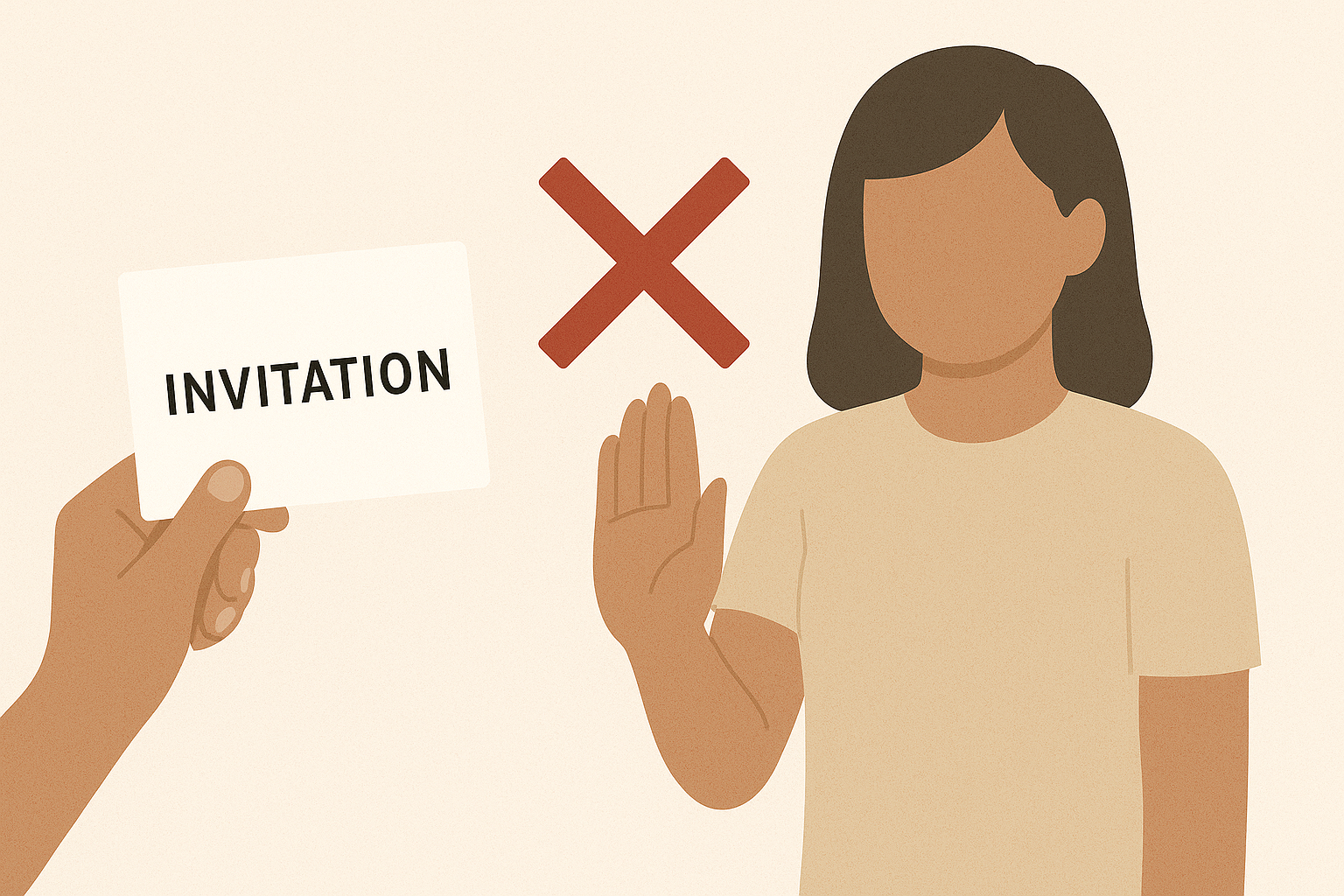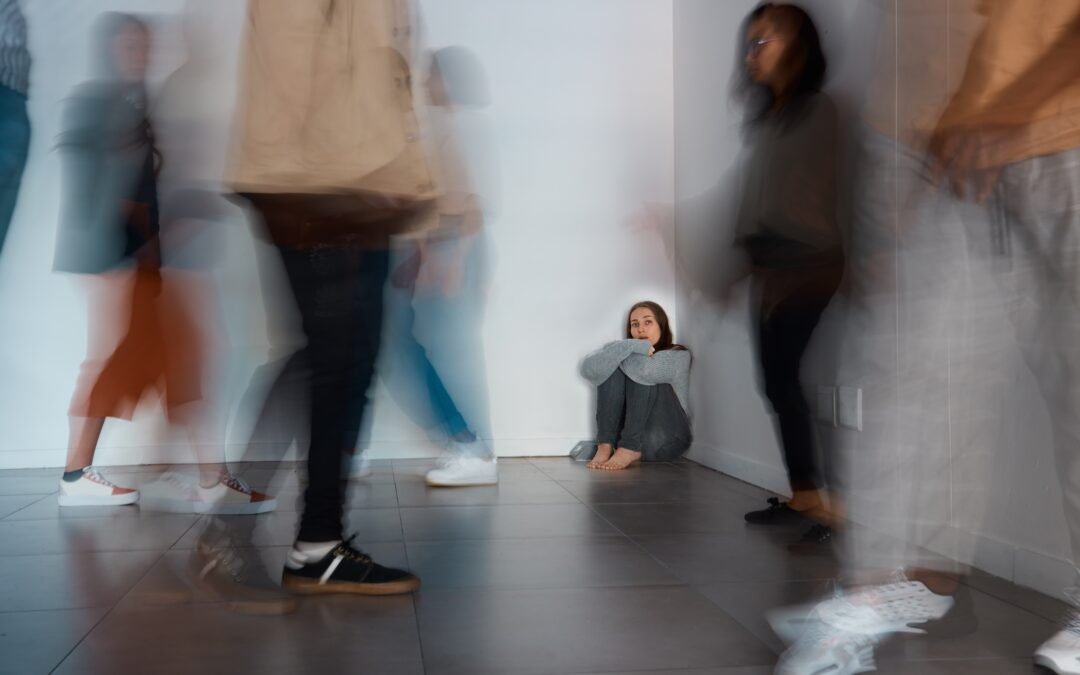I meet with clients who describe a deep fear of social situations, not just shyness, but a pervasive sense of dread that others are watching, judging, or waiting for them to make a mistake. They may appear composed on the outside but feel an inner storm of anxiety, self-criticism, and physical discomfort. This experience is at the heart of social anxiety disorder (SAD), which can impact many individuals, yet often goes unseen and misunderstood.
In this post, I want to explore social anxiety from an integrative perspective. One that looks beyond symptoms and considers the whole person: body, mind, nervous system, relationships, and lived experience. My intention is to offer insight into what social anxiety disorder entails, and to illustrate how healing becomes possible when psychological, physiological, and relational approaches are integrated to restore safety and self-trust.
What Is Social Anxiety Disorder?
Social anxiety disorder, sometimes called social phobia, is characterized by an intense and persistent fear of being judged, embarrassed, or humiliated in social or performance situations. People with SAD often fear that they’ll say or do something that will expose them as awkward, incompetent, or unlikable.
This anxiety isn’t simply nervousness before a presentation or a bit of self-consciousness at a party. It can be debilitating, causing people to avoid social gatherings, withdraw from friendships, or limit their career opportunities. The fear can manifest in physical symptoms such as blushing, trembling, sweating, nausea, or heart palpitations.
Clinically, the DSM-5-TR (Diagnostic and Statistical Manual of Mental Disorders) defines social anxiety disorder as a marked fear or anxiety about one or more social situations in which an individual is exposed to possible scrutiny by others. These fears are persistent (lasting at least six months), out of proportion to actual threat, and cause significant distress or impairment in daily functioning.
Beyond these diagnostic criteria lies the lived experience, a sense of threat that feels woven into the nervous system itself. From an integrative lens, this is where the deeper work begins.
The Roots of Social Anxiety: Beyond “Just Being Shy”
 While genetics and temperament play a role, social anxiety often has developmental, relational, and physiological roots. Many people with SAD describe early experiences that made them feel unsafe being themselves in front of others, perhaps due to critical parenting, bullying, family conflict, or social rejection.
While genetics and temperament play a role, social anxiety often has developmental, relational, and physiological roots. Many people with SAD describe early experiences that made them feel unsafe being themselves in front of others, perhaps due to critical parenting, bullying, family conflict, or social rejection.
From a polyvagal or nervous system perspective, social anxiety can be understood as a state of chronic hypervigilance in social contexts. The body perceives social interaction not as connection, but as potential danger. This is not a conscious choice; it’s an automatic response of a nervous system that has learned, over time, that visibility equals risk.
Early relational wounds
If a child is consistently shamed, interrupted, or dismissed when speaking, they may learn that self-expression leads to disconnection or rejection. Their nervous system begins to associate attention with threat. As adults, they might freeze in conversations, blush when speaking, or ruminate for hours afterward about what they said “wrong.”
Cultural and environmental influences
Our culture can also contribute to social anxiety. Social media amplifies comparison and performance pressure. Many professional or academic environments reward extroversion and confidence, often invalidating those who are naturally introspective. This can reinforce the internal belief that “something is wrong with me if I feel anxious around others.”
The body remembers
Over time, these experiences condition both the brain and body. The amygdala (usually referred to as the brain’s alarm center) becomes hypersensitive to social cues. Muscles tense, breathing becomes shallow, and the body prepares for imagined threat. The mind races with “what if” scenarios: What if I embarrass myself? What if they think I’m boring? What if I turn red and can’t stop?
From an integrative standpoint, we must work with this whole system of fear. Not just challenge thoughts but help the body relearn (or maybe learn for the first time) what safety and connection feel like.
How Social Anxiety Affects Daily Life
Social anxiety weaves itself into nearly every corner of daily functioning. Some clients describe it as “living with an internal critic that never sleeps.” They may:
 Rehearse conversations repeatedly before and after they occur (repeatedly is the key word here)
Rehearse conversations repeatedly before and after they occur (repeatedly is the key word here)- Decline invitations or arrive late to avoid mingling
- Avoid eye contact or social events altogether
- Experience intense physical symptoms (flushing, sweating, shaking) during interactions
- Avoid speaking up in meetings or classes
- Feel drained after socializing, even with close friends (not the same as introversion)
Professionally, it can lead to underemployment, as individuals avoid promotions or leadership roles that require visibility. Personally, it can lead to loneliness despite a strong desire for connection.
It’s important to note that social anxiety isn’t always visible. Many high-functioning individuals mask their discomfort so effectively that others assume they’re confident. Inside, however, they may be enduring profound stress and self-doubt.
The Integrative Approach: Healing the Whole System
Cognitive-behavioral therapy (CBT) remains one of the most evidence-based treatments for social anxiety disorder. But as an integrative therapist, I find that many clients benefit from a multimodal approach that addresses the mind, body, and relational environment simultaneously.
Healing from social anxiety involves more than learning to “think differently.” It’s about retraining the nervous system, rewriting self-beliefs, and restoring a felt sense of safety in connection with others.
The following are the primary components of an integrative approach that I include in treatment:
-
Cognitive and Behavioral Interventions
CBT helps clients identify and challenge distorted beliefs about social evaluation, such as “everyone is judging me” or “if I blush, people will think I’m weak.” Through gradual exposure and cognitive restructuring, clients learn to test these fears and gather new evidence.
Key CBT techniques include:
- Behavioral experiments: Gradually facing feared situations in small, supported steps to build tolerance.
- Exposure hierarchies: Creating a ladder of feared situations and practicing them one by one.
- Self-compassion training: Learning to treat oneself with understanding rather than criticism after social encounters.
- Cognitive reframing: Identifying automatic negative thoughts and replacing them with more balanced perspectives.
From an integrative perspective, CBT provides essential structure and tools, but by itself, it may not reach the embodied layer of fear where social anxiety lives.
-
Somatic and Polyvagal-Informed Work
The body is often the missing link in treating anxiety. When we only target thoughts, we risk overlooking the physiological alarm system that keeps anxiety alive.
Polyvagal theory offers a valuable lens here. It teaches us that social engagement and safety are biological states, not just psychological choices. When the vagus nerve senses safety, our heart rate, breath, and facial expressions align with calm connection. When it detects a threat, our body shifts into fight, flight, freeze, or fawn (please link to fawn page), in the absence of real danger.
Somatic practices that help re-regulate this system include:
- Breathwork to stimulate the parasympathetic nervous system
- Gentle movement or yoga to release tension patterns
- Orienting exercises that help the body locate safety cues in the environment
- Grounding exercises that anchor awareness in the present moment
These techniques teach the nervous system that social interactions are not inherently dangerous, allowing healing to occur from the inside out.
-
Mindfulness and Compassion-Based Practices
Mindfulness-based interventions have proven highly effective for social anxiety. Rather than fighting anxiety, mindfulness helps clients observe it with curiosity. This shift from judgment to awareness interrupts the self-critical cycle that fuels the disorder.
Compassion-focused therapy (CFT) complements this by nurturing an inner stance of kindness and acceptance. Clients learn that their anxiety is not a flaw, it’s a protective strategy developed by a nervous system trying to keep them safe. This reframe can be profoundly healing.
Simple practices such as mindful breathing, guided imagery, or self-compassion meditations can support this transformation. Over time, clients begin to internalize a sense of warmth toward themselves, even when anxiety arises.
-
EMDR and Trauma-Informed Approaches
For clients whose social anxiety stems from past experiences of humiliation, rejection, or bullying, Eye Movement Desensitization and Reprocessing (EMDR) can be a powerful tool. EMDR helps the brain reprocess painful memories that still carry emotional charge.
By accessing these experiences in a safe, guided manner, clients can release the stored fear and shame associated with them. As the emotional intensity decreases, present-day triggers (like speaking in groups or walking through a CVS) often become far less overwhelming.
A trauma-informed lens also ensures that therapy proceeds gently, respecting the body’s pace and boundaries. Healing social anxiety is not about forcing exposure but building capacity for connection over time.
-
Integrating Lifestyle and Functional Wellness
Anxiety is both psychological and physiological, so it may be important to address lifestyle factors that influence the nervous system. Sleep quality, nutrition, gut health, caffeine intake, and blood sugar regulation can all impact anxiety levels.
I may collaborate with an integrative health practitioner, naturopath, or functional medicine practitioner if the client is open to this approach. Things that practitioner may take a closer look at are:
- Gut-brain connection and microbiome balance
- Adrenal fatigue or chronic stress patterns (It’s important to consider the A-HPA axis)
- Impact of alcohol, sugar, or stimulants on anxiety (Especially if a client is consuming energy drinks)
- Nutrient deficiencies (e.g., magnesium, B vitamins, omega-3s)
When the body feels balanced and nourished, emotional regulation becomes much more accessible. Supporting physical health reinforces all other therapeutic efforts.
-
Relational and Attachment Repair
At its core, social anxiety is about fear of rejection and disconnection. Healing, therefore, must happen within the context of safe, attuned relationships, both inside and outside therapy.
In counseling, the therapeutic relationship itself becomes a corrective emotional experience. As clients practice vulnerability and are met with empathy and compassion rather than judgment, their nervous system begins to encode new patterns: It’s safe to be seen. I can be myself and still belong.
Outside therapy, cultivating supportive friendships, joining gentle group settings, or engaging in creative communities can further strengthen social confidence. Connection heals the wounds that isolation deepens.
The Journey of Healing: What It Feels Like
Healing social anxiety is rarely linear. It involves moving between progress and setbacks, between fear and courage. Clients often describe it as learning to befriend their nervous system, to recognize the signs of activation, soothe themselves, and choose connection even when fear whispers “hide.”
Early progress may look like:

- Speaking up once in a meeting
- Realizing the anxiety passed without catastrophe
- Attending a social event and staying a little longer than usual
- Making eye contact with a stranger and feeling okay afterward
Over time, these moments accumulate, rewiring the brain’s expectations of safety. What once triggered panic begins to feel manageable and sometimes even meaningful.
What Clients Work On In Between Sessions
While counseling is highly effective, there are also daily practices that individuals can use to support themselves between sessions:
- Breathe slowly and deeply. Extending the exhale activates the body’s calming response.
- Limit comparison. Social media can distort reality; focus on authentic connection instead.
- Engage the senses. Grounding in sights, sounds, and textures can regulate the nervous system in real time.
- Practice self-observation, not self-judgment. Notice when anxiety arises without labeling it as “bad.”
- Prioritize rest and nutrition. A resilient body supports a calm mind.
- Use gentle exposure. Start small with saying hello to a coworker, asking a cashier a question, or joining a small group activity.
- Write down social successes. Keeping a log of positive interactions helps retrain the brain to notice safety cues.
From Social Fear to Connection
As an integrative counselor, I view social anxiety not as a flaw to eliminate but as a signal from a sensitive nervous system, one that feels deeply and seeks authentic belonging. Many people with social anxiety are empathic, conscientious, and introspective. Their sensitivity can become a strength once it’s no longer governed by fear.

Through integrative counseling, I can help individuals move from avoidance to engagement, from isolation to connection. By working with both the mind and body, healing old wounds, and restoring self-trust, people can rediscover the simple joy of being with others, without the constant vigilance or self-doubt.
When that shift happens, social life no longer feels like a threat, it can become an opportunity for genuine human connection, compassion, and shared growth. If social anxiety is keeping you from living the way you want, please schedule a phone consult today to see if my integrative therapy approach can help.


